江西省教师资格证英语说课稿2english around the world
- 格式:doc
- 大小:38.00 KB
- 文档页数:3
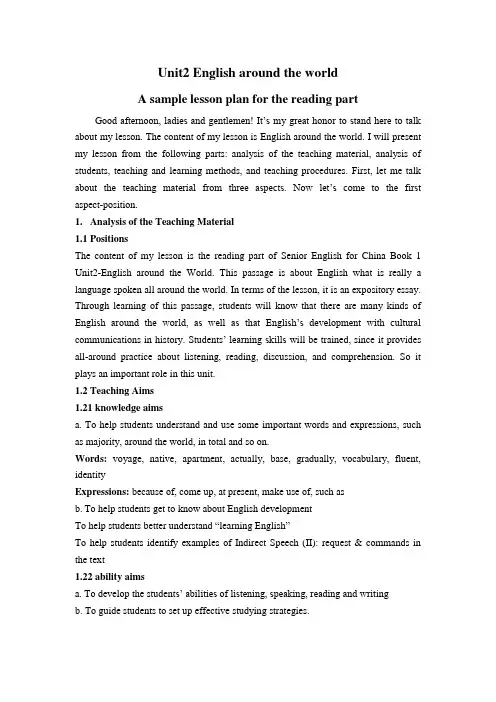
Unit2 English around the worldA sample lesson plan for the reading partGood afternoon, ladies and gentlemen! It‟s my great honor to stand here to talk about my lesson. The content of my lesson is English around the world. I will present my lesson from the following parts: analysis of the teaching material, analysis of students, teaching and learning methods, and teaching procedures. First, let me talk about the teaching material from three aspects. Now let‟s come to the first aspect-position.1.Analysis of the Teaching Material1.1 PositionsThe content of my lesson is the reading part of Senior English for China Book 1 Unit2-English around the World. This passage is about English what is really a language spoken all around the world. In terms of the lesson, it is an expository essay. Through learning of this passage, students will know that there are many kinds of English around the world, as well as that English‟s development with cultural communications in history. Students‟ learning skills will be trained, since it provides all-around practice about listening, reading, discussion, and comprehension. So it plays an important role in this unit.1.2 Teaching Aims1.21 knowledge aimsa. To help students understand and use some important words and expressions, such as majority, around the world, in total and so on.Words: voyage, native, apartment, actually, base, gradually, vocabulary, fluent, identityExpressions: because of, come up, at present, make use of, such asb.To help students get to know about English developmentTo help students better understand “learning English”To help students identify examples of Indirect Speech (II): request & commands in the text1.22 ability aimsa. To develop the student s‟ abilities of listening, speaking, reading and writ ingb. To guide students to set up effective studying strategies.c. To improve the students‟ reading ability, especially their skimming and scanning ability.d. To train the student s‟ abilities of studying by themselves and cooperating.1.23 moral aimsBy studying of this passage, we‟ll enable students to know a brief history of English and also enable them to identify different English. It also develops students‟ interest and enthusiasm in studying English.1.3 Teaching key points and difficult pointsKey points: guiding students to study how is the passage to be structured, such as looking for the topic sentence of every paragraph by skimming and scanning. Difficult points: the comprehension of some words and sentences, the learning and application of some grammar.2. Analysis of the studentsMy targeting students are from grade one. They have learnt English since primary school. Although they have learnt English for at least four years, they don‟t know the brief history of English and may not study English out of interest. They have no idea about varieties of English.3. Teaching and learning methodsAs is known to us all, a good teaching method requires that the teacher should help students develop good sense of the English language. For achieving these teaching aims, I will use the following methods according to the modern social communication teaching theories:Task-based Language Teaching, Communicative Approach, Whole Language Teaching, Total Situational Action. At the same time, CAI can provide a real situation with its sound and picture; it can develop the students‟ creativity in learning English.4.Teaching procedures4.1 Lead inI think the most useful method to lead the students to learn is interest stimulating and discussion by themselves. At beginning I will show them two groups of words and let them guess which one is American English and which one is British English, and askstudents whether they think that native English speakers can understand each other even they don‟t speak the same kind of English. By my given material, they are likely to say yes. But I will tell them that native English speakers may not understand everything of the other speakers. For example, …homely‟in British English means …making you feel comfortable‟, but in American English, it means …ugly, not attractive‟. If a man says it to a British woman, she will be happy while to an American woman she will be angry. After hearing this, my students must be eager to get more information about English around the world. It is the time that we begin our class.4.2 warming upOwe to the lead in part, students know that there is more than one kind of English. And in some important ways they are very different from each another. They are called world Englishes. So I will give them some examples about varieties of English. Then they will be asked to guess which words are British English and which are American English.Examples: elevator/lift in a team/ on a team rubber/eraser petrol/gas picture/movie underground/subway4.3 pre-readingPair work or group work: let students‟ discuss each other and then tell me the keys to the following questions:a. with your partner, list the countries that use English as an official language.b.Which country do you think has the most English learners?c.Look at the title of the passage and guess what it is about. Then read it quickly and see if you are right.4.4 while-reading4.41 SkimmingStudents should read the passage fast to find out the main idea/topic sentence for each paragraph. Lis ten to the passage part by part to develop students‟ listening skills. Paragraph1:The spread of the English language in the worldParagraph2:Native speaker can understand each other even if they don‟t speak thesame kind of English.Paragraph3: English changes and develops when cultures meet and communicate with each other.Paragraph4: English changes and develops when cultures meet and communicate with each other.Paragraph5: English is spoken as a foreign language or second language in South Asia.4.42 ScanningGuide Students to read the passage carefully and take some important notes, then find out the correct answers to finish the following chart with teamwork.Purpose of my design: Enable students to understand the given material better by using different reading skills. And proper competition can arouse the students‟ interest in English learning. “Task-based” teaching meth od is used here to develop the student s‟ ability of communication and also their ability of co-operation will be well trained.4.43 Careful readingRead the passage again carefully and decide whether the statements are true or false and explain why.1. English has the most speakers in the 17th century.2. English developed when new settlers and rulers came to Britain.3. Languages frequently change.4. The language of the government is always the language of the country.5. English is one of the official languages used in India.6. This reading describes the development of the English language.4.44 Words and GrammarI will teach new words in the passage to help them understand the passage. And I will also introduce the direct speech and indirect speech to the students.This step consists of 3 sections: new words, set phrases, grammar.a. New words: actually, elevator, apartment, vocabulary, includeb. Phrases: come up a place, such as, play a role inc. Grammar point: indirect speech.Purpose: To develop s tudents‟ basic reading skills of skimming, scanning and careful reading and the ability to catch the main idea of the passage.4.5 post-readingTasks: a. Sum up the passage in students‟ own words according to the chart. b. Reading the passage again, reviews the knowledge learning in this class.Purpose of my design:I think if students can finish this task well, they will benefit a lot in their spoken English. Most students can take their parts in the activities, especially for the students who have trouble in English study.4.6 HomeworkI think homework should be interesting as well as useful. So I will ask my students to search for some pictures of national flags of major English speaking countries involved in the passage. I will ask them to describe the flags next time. I will also ask them to work in pairs, one says a sentence, and the other changes the direct speech into indirect speech. In this way, students can use what they have learnt in their daily life.Purpose of my design: Homework is so important and necessary to master the knowledge they learned after class. It will check whether the students achieve the teaching aims.。
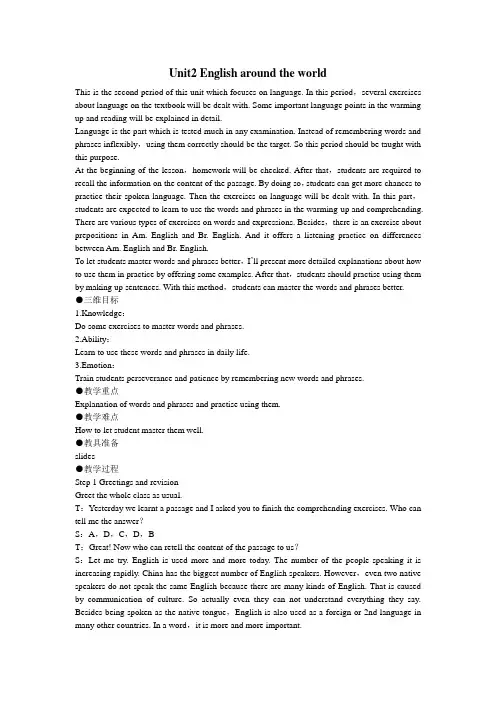
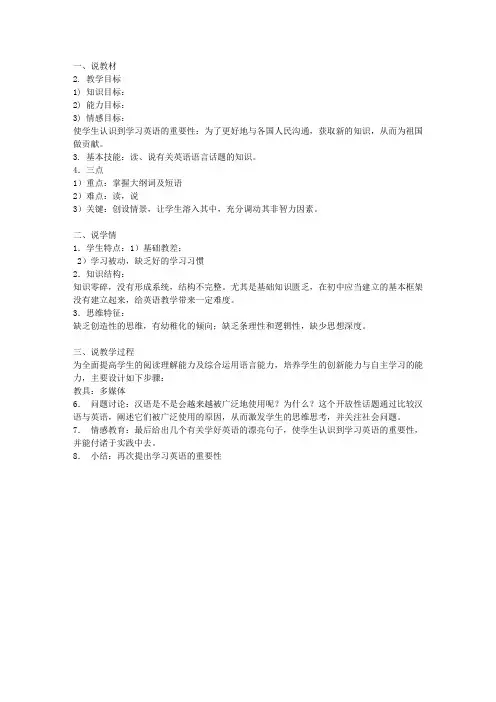
一、说教材
2. 教学目标
1) 知识目标:
2) 能力目标:
3) 情感目标:
使学生认识到学习英语的重要性:为了更好地与各国人民沟通,获取新的知识,从而为祖国做贡献。
3. 基本技能:读、说有关英语语言话题的知识。
4.三点
1)重点:掌握大纲词及短语
2)难点:读,说
3)关键:创设情景,让学生溶入其中,充分调动其非智力因素。
二、说学情
1.学生特点:1)基础教差;
2)学习被动,缺乏好的学习习惯
2.知识结构:
知识零碎,没有形成系统,结构不完整。
尤其是基础知识匮乏,在初中应当建立的基本框架没有建立起来,给英语教学带来一定难度。
3.思维特征:
缺乏创造性的思维,有幼稚化的倾向;缺乏条理性和逻辑性,缺少思想深度。
三、说教学过程
为全面提高学生的阅读理解能力及综合运用语言能力,培养学生的创新能力与自主学习的能力,主要设计如下步骤:
教具:多媒体
6.问题讨论:汉语是不是会越来越被广泛地使用呢?为什么?这个开放性话题通过比较汉语与英语,阐述它们被广泛使用的原因,从而激发学生的思维思考,并关注社会问题。
7.情感教育:最后给出几个有关学好英语的漂亮句子,使学生认识到学习英语的重要性,并能付诸于实践中去。
8.小结:再次提出学习英语的重要性。
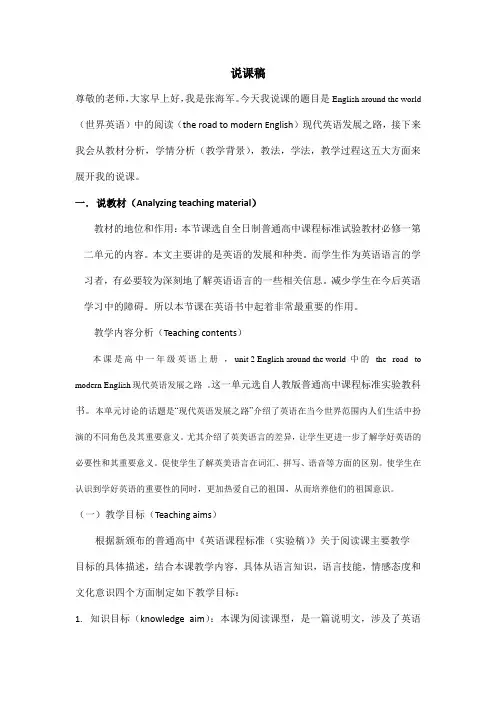
说课稿尊敬的老师,大家早上好,我是张海军。
今天我说课的题目是English around the world (世界英语)中的阅读(the road to modern English)现代英语发展之路,接下来我会从教材分析,学情分析(教学背景),教法,学法,教学过程这五大方面来展开我的说课。
一.说教材(Analyzing teaching material)教材的地位和作用:本节课选自全日制普通高中课程标准试验教材必修一第二单元的内容。
本文主要讲的是英语的发展和种类。
而学生作为英语语言的学习者,有必要较为深刻地了解英语语言的一些相关信息。
减少学生在今后英语学习中的障碍。
所以本节课在英语书中起着非常最重要的作用。
教学内容分析(Teaching contents)本课是高中一年级英语上册,unit 2 English around the world 中的the road to modern English现代英语发展之路。
这一单元选自人教版普通高中课程标准实验教科书。
本单元讨论的话题是“现代英语发展之路”介绍了英语在当今世界范围内人们生活中扮演的不同角色及其重要意义。
尤其介绍了英美语言的差异,让学生更进一步了解学好英语的必要性和其重要意义。
促使学生了解英美语言在词汇、拼写、语音等方面的区别。
使学生在认识到学好英语的重要性的同时,更加热爱自己的祖国,从而培养他们的祖国意识。
(一)教学目标(Teaching aims)根据新颁布的普通高中《英语课程标准(实验稿)》关于阅读课主要教学目标的具体描述,结合本课教学内容,具体从语言知识,语言技能,情感态度和文化意识四个方面制定如下教学目标:1.知识目标(knowledge aim):本课为阅读课型,是一篇说明文,涉及了英语在当今世界范围内人们生活中扮演的不同角色及其重要意义。
尤其介绍了英美英语语言的差异。
通过阅读使学生了解“英语发展之路”的一些基本概况,包括它的重要性和英美英语的差异。
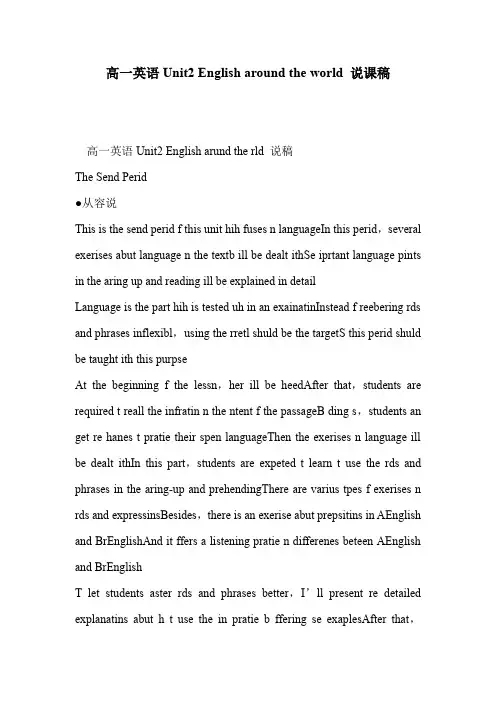
高一英语Unit2 English around the world 说课稿高一英语Unit2 English arund the rld 说稿The Send Perid●从容说This is the send perid f this unit hih fuses n languageIn this perid,several exerises abut language n the textb ill be dealt ithSe iprtant language pints in the aring up and reading ill be explained in detailLanguage is the part hih is tested uh in an exainatinInstead f reebering rds and phrases inflexibl,using the rretl shuld be the targetS this perid shuld be taught ith this purpseAt the beginning f the lessn,her ill be heedAfter that,students are required t reall the infratin n the ntent f the passageB ding s,students an get re hanes t pratie their spen languageThen the exerises n language ill be dealt ithIn this part,students are expeted t learn t use the rds and phrases in the aring-up and prehendingThere are varius tpes f exerises n rds and expressinsBesides,there is an exerise abut prepsitins in AEnglish and BrEnglishAnd it ffers a listening pratie n differenes beteen AEnglish and BrEnglishT let students aster rds and phrases better,I’ll present re detailed explanatins abut h t use the in pratie b ffering se exaplesAfter that,students shuld pratise using the b aing up sentenesith this ethd,students an aster the rds and phrases better●三维目标1nledge:D se exerises t aster rds and phrases2Abilit:Learn t use these rds and phrases in dail life3Etin:Train students perseverane and patiene b reebering ne rds and phrases●教学重点Explanatin f rds and phrases and pratise using the●教学难点H t let student aster the ell●教具准备slides●教学过程Step 1 Greetings and revisinGreet the hle lass as usualT:esterda e learnt a passage and I ased u t finish the prehending exerisesh an tell e the anser?S:A,D,,D,BT:Great!N h an retell the ntent f the passage t us?S:Let e trEnglish is used re and re tdaThe nuber f the peple speaing it is inreasing rapidlhina has the biggest nuber f English speaersHever,even t native speaers d nt spea the sae English beause there are an inds f EnglishThat is aused b uniatin f ultureS atuall even the an nt understand everthing the saBesides being spen as the native tngue,English is als used as a freign r 2nd language in an ther untriesIn a rd,it is re and re iprtant Step 2 Learning abut languageT:u did suh a gd bu have astered the text quite ellThis perid e ill tr t aster the useful rds and expressins in the first peridFirst let’s d exerise 1 in the part f learning abut languagePlease read the rd r phrase and then ath it ith the right eaning(Suggested anser:D E F A B G I H)T:eep these rds in indAnd then hse se f the t fill in the blans in exerise 2 (suggested anser:native,atuall,vabular,apartent,elevatr)T:N e’ll turn t a diffiult neu shuld fill in the blans using the rds fr aring up and readingAt the sae tie,u’d better pa attentin t the frs f the rds (Suggested anser:inludes;ulture;present;Atuall;phrases;gas;internatinal;rapidl;Atuall;gvernent)T:ell dne!As e all n,there’re se differenes beteen British English and Aerian Englishan u give e se exaples?S:(Ss an present their reprt n their researh esterda)Suggested exaples abut differenes beteen AEnglish and BrEnglish inspelling:Aerian EnglishBritish English neighbrhdlabrlrhnrablehurfavritetheaterileteretersberentertravelinglabelinganelingntrledlienseffensepratiedefenserganizatinneighburhdlaburlurhnurablehuurfavuritetheatreiletreetresbreentretravellinglabellinganellingntrlledlieneffenepratisedefenerganisatinT:Seties,the even use different prepsitinsLet’s ve t exerise 4 (Suggested ansers:In AEnglish:n;n;f;n;fr;n;In BrEnglish:in;at;t;int;at)T:Exellentust n u said that British and Aerian English use different rds t express the sae eaningLet’s ve t exerise and find ut the different rds that ean the saeS:seets and and;lrr and tru;autun and fallT:S nie!N please pratise reading the in pairs,paing attentin t the sentene stress and intnatin(Pratie reading fr a fe inutes)Step 3 Language pintsT:Then I’ll explain se useful rds and expressins in aring-up and prehending t u1inlude v(never prgressive)if ne thing inludes anther,it has the 2nd thing as ne f its parts包含,包括egThe prie inludes dinner,beds,and breafastDurable gds inludes suh ites as ars puters and eletrial applianesinluding prepInluded ad(never befre nuns)The bill ae t $40,inluding taxThe bill ae t $40,tax inludedntain v(never prgressive)if sth ntain sth else,it has that thing inside it r as part f it包含;含有;容纳egThis drin desn’t ntain an alhlThere ere fur r five bs ntaining ts and bsThe infratin u need is ntained in this reprtntainer n容器,集装箱2pla a rle 扮演;起作用pla (a rle/part)as in在……中扮演……egnitr plas an iprtant rle in anaging a lassThe rle he plaed as a her in that vie n hi an prizes3the nuber f ……的数量(谓语动词为单数形式)a nuber f大量的;修饰可数名词The nuber f heless peple has inreasedHuge nubers f anials have diedA large nuber f prbles have been raised表示“许多”的词语归纳①只能修饰可数名词的有an,a gd/great an,a (large/great)nuber f,an a (+n)②只能修饰不可数名词的有uh,a great/gd deal f,a great aunt f③可数和不可数均可修饰的有a lt f,lts f,plent f,a large/great quantit f;quantities f4even ifeven thugh 即使He didn’t tae her advie,even thugh he ne it t be trueEven thugh he has gt a gd b,he still ants t l fr a better nent everthingnt与ever,eah,bth,all,everthing,everbd等连用为部分否定,全部否定用n ne,nne,neither,nthing,nbd,nt an等。
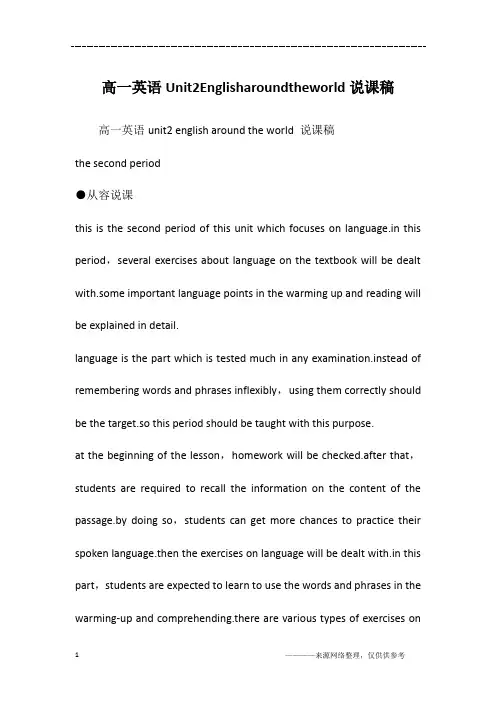
高一英语Unit2Englisharoundtheworld说课稿高一英语unit2 english around the world 说课稿the second period●从容说课this is the second period of this unit which focuses on language.in this period,several exercises about language on the textbook will be dealt with.some important language points in the warming up and reading will be explained in detail.language is the part which is tested much in any examination.instead of remembering words and phrases inflexibly,using them correctly should be the target.so this period should be taught with this purpose.at the beginning of the lesson,homework will be checked.after that,students are required to recall the information on the content of the passage.by doing so,students can get more chances to practice their spoken language.then the exercises on language will be dealt with.in this part,students are expected to learn to use the words and phrases in the warming-up and comprehending.there are various types of exercises onwords and expressions.besides,there is an exercise about prepositions in am.english and br.english.and it offers a listening practice on differences between am.english and br.english.to let students master words and phrases better,i’ll present more detailed explanations about how to use them in practice by offering some examples.after that,students should practise using them by making up sentences.with this method,students can master the words and phrases better.●三维目标1.knowledge:do some exercises to master words and phrases.2.ability:learn to use these words and phrases in daily life.3.emotion:train students perseverance and patience by remembering new words and phrases.●教学重点explanation of words and phrases and practise using them.●教学难点how to let student master them well.●教具准备slides●教学过程step 1 greetings and revisiongreet the whole class as usual.t:yesterday we learnt a passage and i asked you to finish the comprehending exercises.who can tell me the answer?s:a,d,c,d,bt:great!now who can retell the content of the passage to us?s:let me try.english is used more and more today.the number of the people speaking it is increasing rapidly.china has the biggest number of english speakers.however,even two native speakers do not speak the same english because there are many kinds of english.that is caused by communication of culture.so actually even they can not understand everything they say.besides being spoken as the native tongue,english is also used as a foreign or 2nd language in many other countries.in a word,it is more and more important.共6页,当前第1页123456step 2 learning about languaget:you did such a good job.you have mastered the text quite well.this period we will try to master the useful words and expressions in the first period.first let’s do exercise 1 in the part of learning about language.please read the word or phrase and then match it with the right meaning.(suggested answer:c d e f a b j g i h)t:keep these words in mind.and then choose some of them to fill in the blanks in exercise 2.(suggested answer:native,actually,vocabulary,apartment,elevator)t:now we’ll turn to a difficult one.you should fill in the blanks using the words from warming up and reading.at the same time,you’d better pay attention to the forms of the words.(suggested answer:includes;culture;present;actually;phrases;gas;international;rapidly;actually;government)t:well done!as we all know,there’re some differences between british english and american english.can you give me some examples?s:(ss can present their report on their research yesterday)suggested examples about differences between am.english and br.english in spelling:american englishbritish englishneighborhoodlaborcolorhonorablehumorfavoritetheaterkilometermetersombercentertravelinglabelingcancelingcontroledlicenseoffensepracticedefense organizationneighbourhood labourcolourhonourablehumourfavouritetheatrekilometremetresombrecentretravellinglabellingcancellingcontrolledlicenceoffencepractisedefenceorganisationt:sometimes,they even use different prepositions.let’s move to exercise 4.(suggested answers:in am.english:on;on;of;on;from;on;in br.english:in;at;to;into;at)t:excellent.just now you said that british and american english use different words to express the same meaning.let’s move to exercise 5 and find out the different words that mean the same.s:sweets and candy;lorry and truck;autumn and fallt:so nice!now please practise reading them in pairs,paying attention to the sentence stress and intonation.(practice reading for a few minutes.)step 3 language pointst:then i’ll explain some useful words and expressions in warming-up and comprehending to you.1.include v.(never progressive)if one thing includes another,it has the 2nd thing as one of its parts.包含,包括e.g.the price includes dinner,beds,and breakfast.durable goods includes such items as cars computers and electrical appliances.including prep.included adj.(never before nouns)the bill came to $450,including tax.the bill came to $450,tax included.共6页,当前第2页123456 contain v.(never progressive)if sth. contain sth. else,it has that thing inside it or as part of it.包含;含有;容纳e.g.this drink doesn’t contain any alcohol.there were four or five books containing toys and books.the information you need is contained in this report.container n.容器,集装箱2.play a role 扮演;起作用play (a role/part)as... in...在……中扮演……e.g.monitor plays an important role in managing a class.the role he played as a hero in that movie won him many prizes.3.the number of... ……的数量(谓语动词为单数形式)a number of...大量的;修饰可数名词the number of homeless people has increased.huge numbers of animals have died.a large number of problems have been raised.表示“许多”的词语归纳①只能修饰可数名词的有many,a good/great many,a (large/great)number of,many a (+n.)②只能修饰不可数名词的有much,a great/good deal of,a great amount of③可数和不可数均可修饰的有a lot of,lots of,plenty of,a large/great quantity of;quantities of4.even ifeven though 即使he didn’t take her advice,even though he knew it to be true.even though he has got a good job,he still wants to look for a better one.5.not everythingnot与every,each,both,all,everything,everybody等连用为部分否定,全部否定用no one,none,neither,nothing,nobody,not any 等。
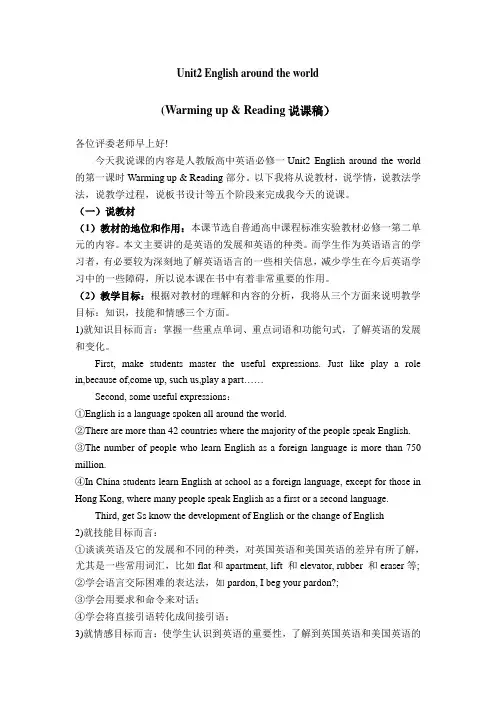
Unit2 English around the world(Warming up & Reading说课稿)各位评委老师早上好!今天我说课的内容是人教版高中英语必修一Unit2 English around the world 的第一课时Warming up & Reading部分。
以下我将从说教材,说学情,说教法学法,说教学过程,说板书设计等五个阶段来完成我今天的说课。
(一)说教材(1)教材的地位和作用:本课节选自普通高中课程标准实验教材必修一第二单元的内容。
本文主要讲的是英语的发展和英语的种类。
而学生作为英语语言的学习者,有必要较为深刻地了解英语语言的一些相关信息,减少学生在今后英语学习中的一些障碍,所以说本课在书中有着非常重要的作用。
(2)教学目标:根据对教材的理解和内容的分析,我将从三个方面来说明教学目标:知识,技能和情感三个方面。
1)就知识目标而言:掌握一些重点单词、重点词语和功能句式,了解英语的发展和变化。
First, make students master the useful expressions. Just like play a role in,because of,c ome up, such us,play a part……Second, some useful expressions:①English is a language spoken all around the world.②There are more than 42 countries where the majority of the people speak English.③The number of people who learn English as a foreign language is more than 750 million.④In China students learn English at school as a foreign language, except for those in Hong Kong, where many people speak English as a first or a second language.Third, get Ss know the development of English or the change of English2)就技能目标而言:①谈谈英语及它的发展和不同的种类,对英国英语和美国英语的差异有所了解,尤其是一些常用词汇,比如flat和apartment, lift 和elevator, rubber 和eraser等;②学会语言交际困难的表达法,如pardon, I beg your pardon?;③学会用要求和命令来对话;④学会将直接引语转化成间接引语;3)就情感目标而言:使学生认识到英语的重要性,了解到英国英语和美国英语的区别,两种英语不存在那种好与不好的问题。
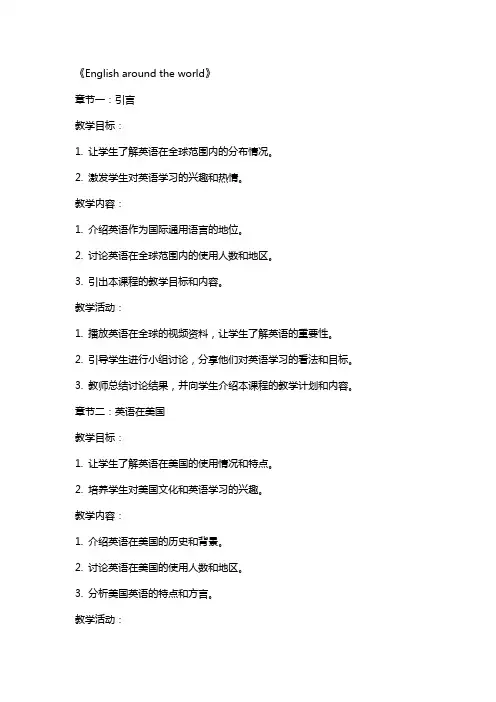
《English around the world》章节一:引言教学目标:1. 让学生了解英语在全球范围内的分布情况。
2. 激发学生对英语学习的兴趣和热情。
教学内容:1. 介绍英语作为国际通用语言的地位。
2. 讨论英语在全球范围内的使用人数和地区。
3. 引出本课程的教学目标和内容。
教学活动:1. 播放英语在全球的视频资料,让学生了解英语的重要性。
2. 引导学生进行小组讨论,分享他们对英语学习的看法和目标。
3. 教师总结讨论结果,并向学生介绍本课程的教学计划和内容。
章节二:英语在美国教学目标:1. 让学生了解英语在美国的使用情况和特点。
2. 培养学生对美国文化和英语学习的兴趣。
教学内容:1. 介绍英语在美国的历史和背景。
2. 讨论英语在美国的使用人数和地区。
3. 分析美国英语的特点和方言。
教学活动:1. 教师播放与美国英语相关的视频资料,让学生了解英语在美国的使用情况。
2. 学生进行小组讨论,分享他们对美国文化和英语学习的看法。
3. 教师引导学生进行听力练习,听懂并模仿美国英语的发音和语调。
章节三:英语在英国教学目标:1. 让学生了解英语在英国的使用情况和特点。
2. 培养学生对英国文化和英语学习的兴趣。
教学内容:1. 介绍英语在英国的历史和背景。
2. 讨论英语在英国的使用人数和地区。
3. 分析英国英语的特点和方言。
教学活动:1. 教师播放与英国英语相关的视频资料,让学生了解英语在英国的使用情况。
2. 学生进行小组讨论,分享他们对英国文化和英语学习的看法。
3. 教师引导学生进行听力练习,听懂并模仿英国英语的发音和语调。
章节四:英语在澳大利亚教学目标:1. 让学生了解英语在澳大利亚的使用情况和特点。
2. 培养学生对澳大利亚文化和英语学习的兴趣。
教学内容:1. 介绍英语在澳大利亚的历史和背景。
2. 讨论英语在澳大利亚的使用人数和地区。
3. 分析澳大利亚英语的特点和方言。
教学活动:1. 教师播放与澳大利亚英语相关的视频资料,让学生了解英语在澳大利亚的使用情况。
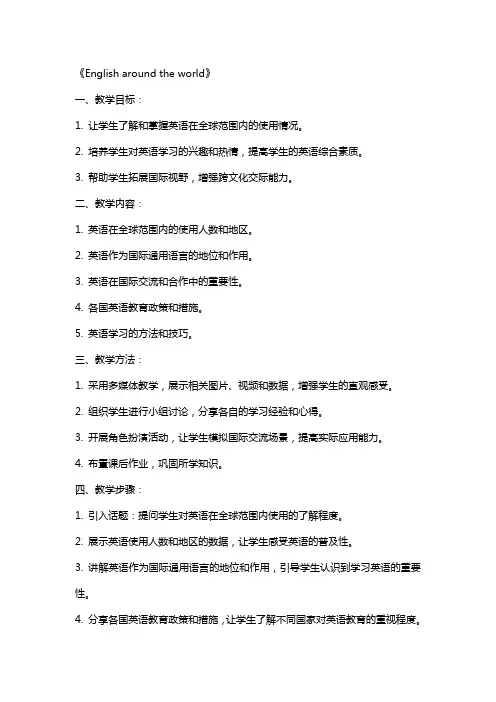
《English around the world》一、教学目标:1. 让学生了解和掌握英语在全球范围内的使用情况。
2. 培养学生对英语学习的兴趣和热情,提高学生的英语综合素质。
3. 帮助学生拓展国际视野,增强跨文化交际能力。
二、教学内容:1. 英语在全球范围内的使用人数和地区。
2. 英语作为国际通用语言的地位和作用。
3. 英语在国际交流和合作中的重要性。
4. 各国英语教育政策和措施。
5. 英语学习的方法和技巧。
三、教学方法:1. 采用多媒体教学,展示相关图片、视频和数据,增强学生的直观感受。
2. 组织学生进行小组讨论,分享各自的学习经验和心得。
3. 开展角色扮演活动,让学生模拟国际交流场景,提高实际应用能力。
4. 布置课后作业,巩固所学知识。
四、教学步骤:1. 引入话题:提问学生对英语在全球范围内使用的了解程度。
2. 展示英语使用人数和地区的数据,让学生感受英语的普及性。
3. 讲解英语作为国际通用语言的地位和作用,引导学生认识到学习英语的重要性。
4. 分享各国英语教育政策和措施,让学生了解不同国家对英语教育的重视程度。
5. 教授英语学习的方法和技巧,帮助学生提高学习效果。
五、课后作业:1. 调查身边的朋友和家人对英语学习的看法和经验,总结分享。
2. 结合自己的生活实际,制定一个个人英语学习计划。
3. 收集有关英语在国际交流中的实际案例,进行分析和讨论。
六、教学评估:1. 课堂参与度:观察学生在课堂讨论、角色扮演等环节的积极性。
2. 作业完成情况:检查学生课后作业的完成质量,评估学生对课堂所学知识的掌握程度。
3. 小组讨论:评估学生在小组讨论中的表现,包括观点阐述、沟通交流等。
七、教学资源:1. 英语在全球使用人数和地区数据来源:联合国教科文组织、世界语言学会等权威机构发布的数据。
2. 英语作为国际通用语言的资料:参考国际组织、各国政府官网等渠道的信息。
3. 各国英语教育政策及措施:查阅相关教育部门和机构发布的政策文件。
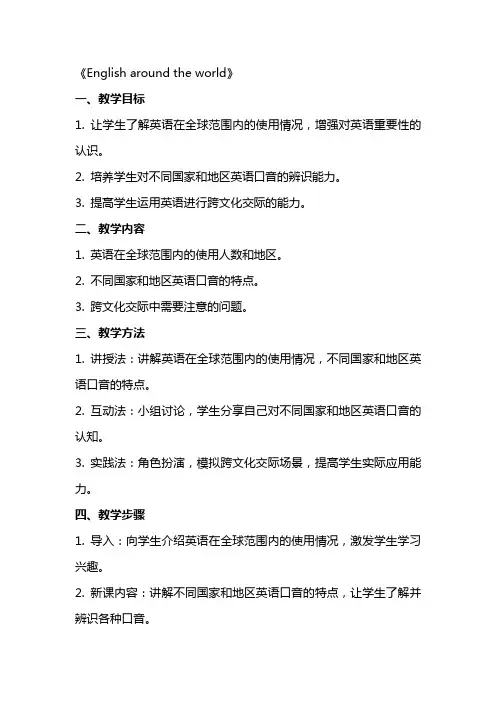
《English around the world》一、教学目标1. 让学生了解英语在全球范围内的使用情况,增强对英语重要性的认识。
2. 培养学生对不同国家和地区英语口音的辨识能力。
3. 提高学生运用英语进行跨文化交际的能力。
二、教学内容1. 英语在全球范围内的使用人数和地区。
2. 不同国家和地区英语口音的特点。
3. 跨文化交际中需要注意的问题。
三、教学方法1. 讲授法:讲解英语在全球范围内的使用情况,不同国家和地区英语口音的特点。
2. 互动法:小组讨论,学生分享自己对不同国家和地区英语口音的认知。
3. 实践法:角色扮演,模拟跨文化交际场景,提高学生实际应用能力。
四、教学步骤1. 导入:向学生介绍英语在全球范围内的使用情况,激发学生学习兴趣。
2. 新课内容:讲解不同国家和地区英语口音的特点,让学生了解并辨识各种口音。
3. 小组讨论:学生分成小组,分享自己对不同国家和地区英语口音的认知,互相学习。
4. 角色扮演:学生分组进行角色扮演,模拟跨文化交际场景,运用所学知识进行实际操作。
5. 总结:对本次课程进行总结,强调跨文化交际的重要性,鼓励学生在日常生活中多练习使用英语。
五、课后作业1. 调查身边的同学和朋友,了解他们的英语学习背景和经历,尝试用英语进行交流。
2. 观看英语电影或电视剧,注意分辨其中的不同英语口音,并尝试模仿。
3. 结合所学内容,总结自己在跨文化交际中需要注意的问题,并在日常生活中加以实践。
六、教学评估1. 课堂参与度:观察学生在课堂讨论、角色扮演等环节的积极参与情况,评估学生的学习兴趣和积极性。
2. 口语表达能力:评估学生在角色扮演等环节中运用英语进行跨文化交际的能力,包括发音、语调、语法等方面。
3. 作业完成情况:检查学生课后作业的完成质量,评估学生对课堂所学知识的掌握程度。
七、教学资源1. 英语全球使用情况数据图表:用于展示英语在全球范围内的使用人数和地区。
2. 英语口音样本:收集不同国家和地区英语口音的音频或视频材料,用于教学和实践环节。
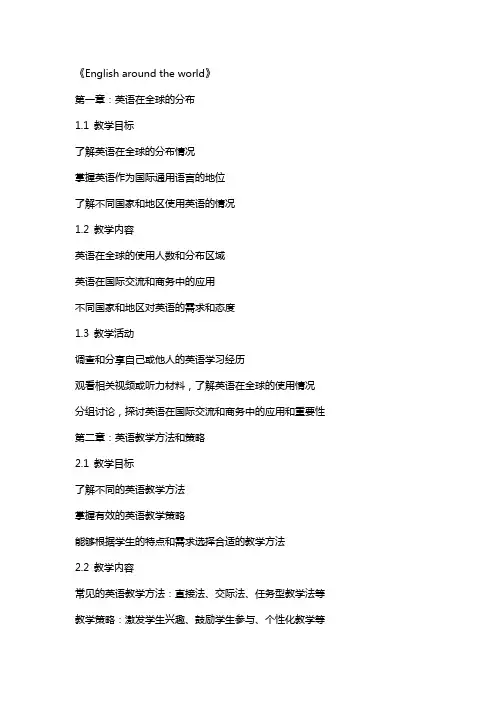
《English around the world》第一章:英语在全球的分布1.1 教学目标了解英语在全球的分布情况掌握英语作为国际通用语言的地位了解不同国家和地区使用英语的情况1.2 教学内容英语在全球的使用人数和分布区域英语在国际交流和商务中的应用不同国家和地区对英语的需求和态度1.3 教学活动调查和分享自己或他人的英语学习经历观看相关视频或听力材料,了解英语在全球的使用情况分组讨论,探讨英语在国际交流和商务中的应用和重要性第二章:英语教学方法和策略2.1 教学目标了解不同的英语教学方法掌握有效的英语教学策略能够根据学生的特点和需求选择合适的教学方法2.2 教学内容常见的英语教学方法:直接法、交际法、任务型教学法等教学策略:激发学生兴趣、鼓励学生参与、个性化教学等如何根据学生的特点和需求选择合适的教学方法2.3 教学活动学习并讨论不同的英语教学方法分享和讨论有效的英语教学策略设计一个针对特定学生群体的英语教学计划第三章:英语教学评估和评价3.1 教学目标了解英语教学评估的目的和方法掌握有效的英语教学评价技巧能够设计和实施英语教学评估活动3.2 教学内容英语教学评估的目的:了解学生的学习进展、调整教学计划等常见的英语教学评估方法:笔试、口试、课堂观察等如何设计和实施有效的英语教学评估活动3.3 教学活动学习并讨论英语教学评估的目的和方法练习设计和实施一个简单的英语教学评估活动分享和讨论评估结果对学生学习的影响第四章:英语教学资源和方法4.1 教学目标了解英语教学资源的种类和来源掌握有效利用英语教学资源的方法能够选择和使用合适的英语教学资源4.2 教学内容英语教学资源的种类:教材、多媒体资源、网络资源等英语教学资源的来源:出版社、教育机构、个人创作等如何有效利用英语教学资源进行教学活动4.3 教学活动学习并讨论英语教学资源的种类和来源搜索和分享自己喜欢的英语教学资源设计一个利用英语教学资源的教学活动第五章:英语教学中的跨文化交际5.1 教学目标了解跨文化交际在英语教学中的重要性掌握跨文化交际的基本原则和技巧能够设计和实施跨文化交际的英语教学活动5.2 教学内容跨文化交际的基本概念和定义跨文化交际在英语教学中的重要性跨文化交际的基本原则和技巧5.3 教学活动学习并讨论跨文化交际的基本概念和定义分享和讨论跨文化交际的实例和经验设计一个跨文化交际的英语教学活动第六章:英语教学中的口语技能培养6.1 教学目标理解口语技能在英语教学中的重要性掌握培养口语技能的策略和方法能够设计针对口语技能提升的英语教学活动6.2 教学内容口语技能的定义和重要性培养口语技能的策略:模仿、对话、讨论、演讲等如何在英语教学中融入口语技能的培养6.3 教学活动学习并讨论口语技能的定义和重要性通过角色扮演和小组讨论练习口语技能设计一个针对特定口语技能提升的英语教学计划第七章:英语教学中的听力技能培养7.1 教学目标理解听力技能在英语教学中的重要性掌握培养听力技能的策略和方法能够设计针对听力技能提升的英语教学活动7.2 教学内容听力技能的定义和重要性培养听力技能的策略:听力材料的选择、听力技巧的教授、听力训练的设计等如何在英语教学中融入听力技能的培养学习并讨论听力技能的定义和重要性使用听力材料进行听力训练,练习听力技巧设计一个针对特定听力技能提升的英语教学计划第八章:英语教学中的阅读技能培养8.1 教学目标理解阅读技能在英语教学中的重要性掌握培养阅读技能的策略和方法能够设计针对阅读技能提升的英语教学活动8.2 教学内容阅读技能的定义和重要性培养阅读技能的策略:阅读材料的选择、阅读技巧的教授、阅读训练的设计等如何在英语教学中融入阅读技能的培养8.3 教学活动学习并讨论阅读技能的定义和重要性使用阅读材料进行阅读训练,练习阅读技巧设计一个针对特定阅读技能提升的英语教学计划第九章:英语教学中的写作技能培养9.1 教学目标理解写作技能在英语教学中的重要性掌握培养写作技能的策略和方法能够设计针对写作技能提升的英语教学活动写作技能的定义和重要性培养写作技能的策略:写作话题的选择、写作技巧的教授、写作反馈的给予等如何在英语教学中融入写作技能的培养9.3 教学活动学习并讨论写作技能的定义和重要性通过写作练习和小组讨论练习写作技能设计一个针对特定写作技能提升的英语教学计划第十章:英语教学中的语法和词汇教学10.1 教学目标理解语法和词汇在英语教学中的重要性掌握有效的语法和词汇教学策略能够设计针对语法和词汇教学的英语教学活动10.2 教学内容语法和词汇在英语教学中的重要性有效的语法和词汇教学策略:规则讲解、实例展示、练习应用等如何在英语教学中融入语法和词汇的教学10.3 教学活动学习并讨论语法和词汇在英语教学中的重要性通过语法和词汇练习巩固学习内容设计一个针对特定语法和词汇教学的英语教学计划重点和难点解析一、英语在全球的分布:理解英语作为国际通用语言的地位和不同国家和地区使用英语的情况。
Unit 2 English around the world说课稿各位老师:大家好!我是XX号考生XX,来自XXXX。
我今天所说的课题是高中一年级英语上册第2单元English around the world。
我说课的内容包括五部分,包括教材分析,学生分析,教学方法,教学过程和板书设计。
1.教材内容分析今天我说课的内容是高一英语必修1第一单元English around the world.,本单元讨论的话题是“世界英语”介绍了英语在当今世界范围内人们生活中扮演的不同角色及其重要意义。
尤其介绍了英美语言的差异,让学生更进一步了解学好英语的必要性和其重要意义。
促使学生了解英美语言在词汇、拼写、语音等方面的区别。
使学生在认识到学好英语的重要性的同时,更加热爱自己的祖国,从而培养他们的祖国意识。
2、教学目标分析新课标提出了立体三维教学目标,本课我设计的教学目标如下:1)知识目标:熟悉本课的一些新单词,短语和句型。
语法方面掌握直接引语和间接引语的用法及其之间的转换,包括其中的请求与命令的用法。
2)能力目标:训练学生的阅读技巧(略读、寻读等),形成用英语获取信息、处理分析信息的能力。
并鼓励学生开口说英语。
3)情感态度目标:①通过学习激发学生对英语学习的浓厚兴趣;②使学生在领会语言丰富多彩性的同时更加热爱自己的祖国,从而培养他们的祖国意识。
培养他们的跨国文化意识和世界意识。
③通过对课文学习的小组讨论等形式,帮助学生养成团结、协作的品质。
3、教学重点、难点:1)教学重点:①让学生熟悉与本话题相关的一些重点单词、短语。
②提高学生的阅读能力,掌握多种阅读方法,如寻读,精读,理解等。
2)教学难点:对阅读中所获取的信息进行加工学习,形成有效的学习策略。
鼓励学生开口说英语。
高一年级的学生已经在初中阶段的英语学习中,已经积累了一定的词汇基础,并掌握了一些简单的学习策略和技巧,具有初步的英语听说读写能力。
但学生的英语水平参差不齐,教学既要进一步培养尖子的学习能力又要保证能力稍弱的学生能听懂,调动他们的积极性,使他们愿意学,在学习的过程中享受到乐趣。
教案二题目:English around the World(人教版必修一第一单元课时2 : warming up and reading)一、题目:Unit two:English around the World二、课时安排:Part1-- warming up and reading(1课时)三、课型:新课四、教学目标:知识目标、能力目标、情感目标1、知识目标Master the different of AE and BE, especially some important wordsUnderstand the passage THE ROAD TO MORDEN ENGLISH2、能力目标Be aware of the different of AE and BETrain students’ reading skill.3、情感目标Let students know more about English and inspire students to study English hard.五、教学重点、难点Teaching important points:Make student aware of the different of AE and BEImprove students’ reading skills.Teaching difficult points:Make student aware the different of AE and BEImprove students’ reading skills.六、学情分析学生特点:作为刚上高中的学生,对高中的一切都还充满好奇,学习主动向强,应该有意识的在这方面给他们加强鼓励,培养他们对英语的兴趣,这对他们今后三年的学习具有深远影响。
通过三年的学习,他们已经非常熟悉英语课堂,对英语学习有着浓厚的兴趣,但是英语的听读能力还有待于加强;学生有过较多的小组合作经验,思维活跃,善于和同学交流,乐于表达自己的观点,对事物已有独自见解,渴望获得同学和教师的赞许;作为高一的孩子,具有较强的探究欲望,思维能力基本实现从具体思维向抽象思维的过渡。
高一英语Unit2 English around theworld 说课稿高一英语Unit2Englisharoundtheworld说课稿TheSecondPeriod●从容说课Thisisthesecondperiodofthisunitwhichfocusesonlangua ge.Inthisperiod,severalexercisesaboutlanguageonthetextbookwillbedea ltwith.Someimportantlanguagepointsinthewarmingupand readingwillbeexplainedindetail.Languageisthepartwhichistestedmuchinanyexamination. Insteadofrememberingwordsandphrasesinflexibly,usingthemcorrectlyshouldbethetarget.Sothisperiodsho uldbetaughtwiththispurpose.Atthebeginningofthelesson,homeworkwillbechecked.Afterthat,studentsarerequiredtorecalltheinformationontheconte ntofthepassage.Bydoingso,studentscangetmorechancestopracticetheirspokenlangu age.Thentheexercisesonlanguagewillbedealtwith.Inthispart,studentsareexpectedtolearntousethewordsandphrasesin thewarming-upandcomprehending.Therearevarioustypeso fexercisesonwordsandexpressions.Besides,thereisanexerciseaboutprepositionsinAm.EnglishandBr .English.Anditoffersalisteningpracticeondifferences betweenAm.EnglishandBr.English.Toletstudentsmasterwordsandphrasesbetter,I’llpresentmoredetailedexplanationsabouthowtousethemi npracticebyofferingsomeexamples.Afterthat,studentsshouldpractiseusingthembymakingupsentences. withthismethod,studentscanmasterthewordsandphrasesbetter.●三维目标.knowledge:Dosomeexercisestomasterwordsandphrases.2.Ability:Learntousethesewordsandphrasesindailylife.3.Emotion:Trainstudentsperseveranceandpatiencebyrememberingne wwordsandphrases.●教学重点Explanationofwordsandphrasesandpractiseusingthem.●教学难点Howtoletstudentmasterthemwell.●教具准备slides●教学过程Step1GreetingsandrevisionGreetthewholeclassasusual.T:yesterdaywelearntapassageandIaskedyoutofinishthecom prehendingexercises.whocantellmetheanswer?S:A,D,c,D,BT:Great!Nowwhocanretellthecontentofthepassagetous?S:Letmetry.Englishisusedmoreandmoretoday.Thenumberoft hepeoplespeakingitisincreasingrapidly.chinahasthebi ggestnumberofEnglishspeakers.However,eventwonativespeakersdonotspeakthesameEnglishbecaus etherearemanykindsofEnglish.Thatiscausedbycommunicationofculture.Soactuallyeventheycannotunderstandeve rythingtheysay.Besidesbeingspokenasthenativetongue,Englishisalsousedasaforeignor2ndlanguageinmanyother countries.Inaword,itismoreandmoreimportant.Step2LearningaboutlanguageT:youdidsuchagoodjob.youhavemasteredthetextquitewell. Thisperiodwewilltrytomastertheusefulwordsandexpress ionsinthefirstperiod.Firstlet’sdoexercise1inthepartoflearningaboutlanguage.Please readthewordorphraseandthenmatchitwiththerightmeanin g.(Suggestedanswer:cDEFABjGIH)T:keepthesewordsinmind.Andthenchoosesomeofthemtofilli ntheblanksinexercise2.(suggestedanswer:native,actually,vocabulary,apartment,elevator)T:Nowwe’llturntoadifficultone.youshouldfillintheblanksusing thewordsfromwarmingupandreading.Atthesametime,you’dbetterpayattentiontotheformsofthewords.(Suggestedanswer:includes;culture;present;Actually;phrases;gas;international;rapidly;Actually;government)T:welldone!Asweallknow,there’resomedifferencesbetweenBritishEnglishandAmericanEn glish.canyougivemesomeexamples?S:(Sscanpresenttheirreportontheirresearchyesterday)SuggestedexamplesaboutdifferencesbetweenAm.Englisha ndBr.Englishinspelling:AmericanEnglishBritishEnglishneighborhoodlaborcolorhonorablehumorfavoritetheaterkilometermetersombercenter traveling labeling canceling controled license offense practice defense organization neighbourhood labourcolour honourable humour favourite theatre kilometre metresombrecentretravellinglabellingcancellingcontrolledlicenceoffencepractisedefenceorganisationT:Sometimes,theyevenusedifferentprepositions.Let’smovetoexercise4.(Suggestedanswers:InAm.English:on;on;of;on;from;on;InBr.English:in;at;to;into;at)T:Excellent.justnowyousaidthatBritishandAmericanEngli shusedifferentwordstoexpressthesamemeaning.Let’smovetoexercise5andfindoutthedifferentwordsthatmean thesame.S:sweetsandcandy;lorryandtruck;autumnandfall T:Sonice!Nowpleasepractisereadingtheminpairs,payingattentiontothesentencestressandintonation.(Practicereadingforafewminutes.)Step3LanguagepointsT:ThenI’llexplainsomeusefulwordsandexpressionsinwarming-upa ndcomprehendingtoyou..includev.(neverprogressive)ifonethingincludesanother,ithasthe2ndthingasoneofitsparts.包含,包括e.g.Thepriceincludesdinner,beds,andbreakfast.Durablegoodsincludessuchitemsascarscomputersandelec tricalappliances.includingprep.Includedadj.(neverbeforenouns)Thebillcameto$450,includingtax.Thebillcameto$450,taxincluded.containv.(neverprogressive)ifsth.containsth.else,ithasthatthinginsideitoraspartofit.包含;含有;容纳e.g.Thisdrinkdoesn’tcontainanyalcohol.Therewerefourorfivebookscontainingtoysandbooks.Theinformationyouneediscontainedinthisreport.containern.容器,集装箱2.playarole扮演;起作用play(arole/part)as...in...在……中扮演……e.g.monitorplaysanimportantroleinmanagingaclass.Theroleheplayedasaherointhatmoviewonhimmanyprizes.3.thenumberof...……的数量(谓语动词为单数形式)anumberof...大量的;修饰可数名词Thenumberofhomelesspeoplehasincreased.Hugenumbersofanimalshavedied.Alargenumberofproblemshavebeenraised.表示“许多”的词语归纳①只能修饰可数名词的有many,agood/greatmany,a(large/great)numberof,manya(+n.)②只能修饰不可数名词的有much,agreat/gooddealof,agreatamountof③可数和不可数均可修饰的有alotof,lotsof,plentyof,alarge/greatquantityof;quantitiesof4.evenifeventhough即使Hedidn’ttakeheradvice,eventhoughheknewittobetrue.Eventhoughhehasgotagoodjob,hestillwantstolookforabetterone.5.noteverythingnot与every,each,both,all,everything,everybody 等连用为部分否定,全部否定用noone,none,neither,nothing,nobody,notany等。
Unit2 English around the worldwarming up + listeningGood afternoon, dear teachers, I’m happy to be here sharing my teaching ideas with you. The content of my lesson is warming up and listeng from Unit 2 “English around the world”, and I’m going to beg in the lesson from the following parts.First is the teahing material analyzing. The central topic of this unit is “English around the world”. This unit seeks to give students a better understanding of how English developed and how it is spoken in the world. Students often hear talk about “standard English”, in fact, as this unit hopes to make clear, there is no such thing as one standard of spoken or written English. English is spoken in many countries throughout the world and many of them have different forms of expressions. And the warming up shows the different spellings in Brish English and American English, which makes the students feel the different English. And the listening section furtherly shows the different accents in different areas in America. This section broadens students’ horizon and forces them to think about the reasons of these differences. This lesson aims to open a window for students to learn English. Actually, the topic can arouse students’ interest quickly, because they all have leant English for so many years. However, they may just know different countries have diffenent accents of English, they have no chance to feel it or even think about the reasons. Besides, the students in our school have differences in personality and proficiency. So my teaching design should meet the need of different students.The teaching objectives of this lesson focus on the following. To realize different kinds of English, especially the difference between British English and American English, such as so me words. To train students’ listening and speaking skills. To increase students’ interest in learning English, broaden students’ international mind and understand the cultural diversity. And the teaching important and difficult point is to increase studen ts’ listening and speaking skills. And the discovery learning method is used in this lesson, which gives a chance to students to find out the differences between BE and AE.Teaching procedure:Step1. Lead in. At the beginning of the class, I will show the students a video which was very popular on the internet. It is about a Chinese guy imitate English accents of different countries, including India, Britain, America and Australia. The video can catch students’ attention in no time, and also gives some basic knowledge about English around the world.Step2. Warming up. This activity introduces the two major variants of English and shows some of the more common differences. So I’d like to a sk students to read the dialogue below and ask them if they can understand what they are talking about. It seems that B gave some irrelarant answers to A’s questions. But is that true? Why? Then list some words on the blackboard and ask the students if they know which one is American English and which one is British English.Step3. Listening. To give students a chance to feel the different accents of English, we are going to listen to a tape about Houston, Texas, a city in the American South. This ia an example of the local dialect. Before listening, we tend to scan the listening text, aiming to know the genenal idea of the text. After that, listen to the tape and focus on the different accents and guess their meanings.Step4. Speaking. According to the facts about different variants of English, a topic will be given to students to discuss and state their opinion. “What are the reasons for the differences of English?” There is no need to analyze the question in depth, just talk about some common elements, such as time, culture, zone and so on.Step5. Make a summary of the lesson and assign homework.Teaching reflection: After having the lesson, the students suppose to realize the different kinds of English, such as spelling, pronounciation and culture and so on. And increase the interest and confidence in learning English. Besides, after finishing the tasks, students can train and improve their listening ans speaking skills. But this lesson only solves some simple questions, students have no chance to find out the deeper reasons.Unit2 English around the worldpre-reading+readingGood afternoon, dear teachers, I’m happy to be here sharing my teaching ideas with you. The content of my lesson is pre-reading and reading from Unit 2 “English around the world”, and I’m going to begin the lesson from the following parts.First is the teahing material analyzing. The central topic of this unit is “English around the world”. This unit seeks to give students a better understanding of how English developed and how it is spoken in the world. Students often hear talk about “standard English”, in fact, as this unit hopes to make clear, there is no such thing as one standard of spoken or written English. English is spoken in many countries throughout the world and many of them have different forms of expressions. Pre-reading has three questi ons, trying to activate students’ former knowledge about this topic and also urges them to think about the reading passage. The reading passgae in this unit offers a very brief history of the English language. Since it presents information in chronological order, it is best to examine it paragraph by paragraph. And most of the background knowledge given below only serves as reference and should not spend too much time introducing all the details to students. The students in our school have a general level in English, and they have differences in personality and proficiency, which shoule be considered into the teaching.Teaching objectives: to learn some new words and expressions; to realize the development of modern English; to train reading ability; to keep the interest in learning English.Teaching procedures:Step1. Lead in. Show a world map and ask students to point out which countries use English as an official language and what are the differences. Which country has the most English learners? Look at the title of the passage and guess what it is about. “The road to modern English”means the development of English from an old one. And choose the main idea of the text. (this activity aims to activate students’ interest and participation in learning the rea ding text.)Step2. Skimming: find out the topic sentence of each paragrah. This is an important skill in high school English,which will do great help in exams. So this task aims to give all students a chance to practise.Step3. careful reading: find out the timeline of the development of English. This passage is written in an order of time, so this is a clue to figure out the structue of the whole passage and have a basic understanding about it. After finding the time, a group work can be assgined to students: explore what happened during the process of the development. When drawing out the timeline of the development of English, ask students a question This question will make students read the text once again and try to understand the author’s intention. “What does the author really want to tell us?”Step4. Discussion. “How did English become so powerful?” This question can check students’ understanding about the text and also make a summary about what they have leant.Step5. Summary and homework.Teaching reflection: After learning the passage, students should have a brief understanding about the development of modern English. And through these reading tasks and questions, students should learn and strengthen the reading skills.。
Unit2 English around the world“English aroundGood morning, everyone. Today I am going to talk about Unit2the world”, taken from PEP Book1. My introduction consists of five parts: analysis of teaching materials, teaching aims, teaching methods, teaching procedures and homework.Part1 Analysis of teaching materialsThis part includes two aspects1、teaching contentaround the world”, this unit will introduce students theWith the topic of “Englishdevelopment of English. And this lesson will cover warming-up, pre-reading and skimming, s o as to activate p rior knowledge h at students l earnt before. A fter.finishing that, students will have a general idea of“the road to modern English”2、status of teaching materialWhen learning this unit, students are trying to get use to the teaching and study methods of middle school. Therefore, it is very important to teach in appropriate and efficient way. This lesson is a lead-in and reading lesson aiming at helping students g et some b ackground knowledge and learn more about English. A fterthis lesson, students may know why there is not only one kind of English and the development of English.Part2 Teaching aimsKnowledge aims(1)Students are able to get general information about kinds of English.(2)Students can know some English-speaking countries and how they influenceEnglish.(3)Students are able to make a timeline of English development.1、Ability aims(1) Enable students to know some difference b etween British English andAmerican English.’ listening skill(2) To develop students(3) To improve the Ss’ reading abilities ,especially their skimming and scanningability.3、Emotional aimsTo arouse students’ interests in learning English, know the international standingof English and know more about communication.4、Key points and difficult pointsKey point is to get students to know the diversity of English, have a general ideaof the development of English. But students lack of geography a nd history knowledge of the text.Part3 teaching methodsAnalysis of Teaching methodsBrainstorming activates the students and come into the topic naturally.’ attention.A game to draw studentsTask-based teaching method enables the students t o read and learn more efficiently.Multi-media assistance arouses t he students’interest, c uriosity a nd desire f or learning.Analysis of learning methodsStudents are the main body of the class, so I will try my best to urge students toEnglish by thinkinglearn by themselves: to get they to know to the diversity ofabout a question, to discover the fun in learning English by listening to radio, to train ability of teamwork by finishing reading task.Part 5 Analysis of Teaching procedures.1、Lead-in(1)True o r false. I n this part, students will judge”there is o nly one k ind ofis true or false, t hen think about w hy. S tudents w ill have one English”minute to think about it.Students are not very interesting in this type of topic. So it is important forteacher t o lead students t o lead students t o find interestingness in it.Asking a question c an lead students t o think, t hereby e xciting s tudents’drive to learn. Through this part, students can understand”worldenglishes”.(2)Let’s guess.In this part, students will listen to tape with several kinds of Englishrecordings in it. American English: it is veryhot today. British English: what ahot day. Canada English: yep, I like it. Singlish: there are three students inthe class. Choices w ill be given on ppt. After that, one of students w ill beasked to guess. If she/he h as correct a nswer, h e can get a present a nddecide who will be the next to guess. Then I will analyses t he special pronunciation in each kind of E nglish and point out that although there are’t abuse them.different kinds of English, we can2 ·Warming-up:different words but same meaningStudents may wonder what kind of English they are learning. They will get the answer this part. British English and American English are two most widely used and acknowledged English. I will mention f ilm (British E nglish) andmovie(American English) to show the difference between British English and American English. Also, I list these words on ppt: subway, lift, gas, apartment, eraser, in a team and ask students to give the relative word.3、Pre-reading(1)Let’s findI will show a world map on the computer screen and ask students to think about where a re the English-speaking countries a nd why do they speak English. A fter students’discussion, some s tudents w ill be asked t o sharetheir opinion. A nd then I will mark the speaking c ountries w ith blue and mention some countries that had an important influence in English. Meanwhile, I will express how English spread to these countries. F or example, in 17th century, as Britain occupy and colonize other parts of the world, English began to spread.This part is to get students to know enoughbackground so that they canread the text easily. Also, students will know the process of English development and finish question1 in pre-reading part.2、Reading(1)Students will be asked to read the text with scanning and skimming skills,that is to read the text quickly a nd finish task2 i n after reading p art----make a timeline of the development of English.In this part, student will work in pairs and have a discussion. After that, some students w ill be asked t o share their timelines. I will work with the students t o see whether t heir answers a re right or not give the reference answer.’ ability of searching information This activity aims at developing studentsand work in team. Also, it makes the task easier to finish and have a general idea of the passage.Part 6 HomeworkFinish exercise1 comprehending partRead the passage carefully and review words and phrases.。
各位评委老师大家好!我是12号考生,今天我说课的内容是人教版高一英语Unit 2 English around the world。
以下我将从说教材,讲教学目标,说教学方法,教学过程,板书设计和教学效果,六个阶段来完成今天的说课。
首先,我们分析下教材,This unit is to introduce English language and its development to us. The reading passage is the center of this unit. It is the most important teaching material in this lesson, which contains most of the vocabularies and grammar points that students should learn.根据对教材的理解和内容的分析,我将从知识,技能和情感三个方面来说明教学目标:The knowledge aim is to help students understand and master the new words, phrases and sentence patterns and have deeper understanding of the topic ----English. The ability aim is to grasp some reading ability such as guessing, skimming, scanning and so on. The emotional aim is to make students understand the spread of English 下面我们来说下学生的情况,Although the students have the basic abilities of learning, speaking, reading and writing, they still need many opportunities to practice what they have learned and to develop their autonomous and cooperative learning ability.Based on the requirement of the syllabus, the important point is help students understand and master the important words, phrases and expressions.(differences between American English and British English in spelling and expressions) The difficult point is to help students master the grammar points. (---identify examples of Direct Speech & Indirect Speech (2): requests and commands in the text) 下面来探究我们的教学方法。
说课稿二
题目:English around the World
(人教版必修一第一单元课时2 : warming up and reading)
Good morning, dear judge
I’m number 1 for English. Today my topic is travel journal (part 1 warming up and pre-reading)
下面我将从说教材、说学情,说教法和学法、说教学过程、说板书设计五个方面来对本课进行说明。
第一,说教材
本课时是人教版高中英语必修1第二单元,是高中生学习英语知识的重要板块之一。
本单元主题是“世界上的英语”,谈论英语本身的知识,这对学生了解英语知识,了解语言变化趋势,明白为什么有多重英语等有重要作用。
根据教材,学生知识水平以及情感需求,我确定本节课的教学目标分为三个方面:
1、知识目标
Aware the different of AE and BE, especially some important words
Understand the passage THE ROAD TO MORDEN ENGLISH
2、能力目标
Be aware of the different of AE and BE
Train students’ reading skill.
3、情感目标
Let students know more about English and make students be interested in English.
教材重难点方面
Teaching important points and teaching difficult points:
Make student aware of the different of AE and BE
Improve students’ reading skills.
三、说学情
学生特点:作为刚上高中的学生,对高中的一切都还充满好奇,学习主动向强,应该有意识的在这方面给他们加强鼓励,培养他们对英语的兴趣,这对他们今后三年的学习具有深远影响。
在英语学习上,他们已经具有了基础知识,但是对各国英语的差异则了解很少,有待提高。
三、说教法和学法
教法:1、迁移法,利用汉语方言差异这个文化现象,引出主题,从学生熟悉的东西入手,引起学生兴趣。
2、交流法,通过师生交流使学生意识到英美英语的差异,和一些具
体的词汇。
3、问答法,增强学生表达能力,积极参与,为reading做准备。
4、快速阅读法,利用快速阅读法提高学生阅读水平。
5、分组讨论法,讨论文章最后留下的问题,only time will tell.深化学生对语言随时代变迁的理解。
学法:学生在上课过程中要跟进老师,积极参与,与老师的步骤同步,形成良好的学习习惯和方法。
七、教学程序
Step 1.(5分钟)导入以中文方言的发音区别,和有关的趣事,引出英语也有同样特点,在不同的地方有不同的特点,引起学生兴趣。
说到方言,可能每个学生都会有自己的见解,于此作为引导,可以很快吸引学生进入正题。
Step2. (5分钟)引入英语差异,进行交流
Warming up 和展示本课需要学的主要的AE 和BE的区别的词如:
Am. English:elevator;on a team;eraser;gas
Br .English:lift;in a team;rubber;petrol
此处顺利过渡到英语的各国差异这个表现上来,在交流中让学生了解英语相关现象,并进入课文warming up。
Step3. (5分钟)pre-reading展示背景知识,采用问答法。
在做好前面的准备之后,学生已经对英语差异的现象有所了解,通过问答,进一步拓展他们的知识范围,为接下来的阅读做好准备。
同时也使学生带着问题去读,提高效率。
Do you know which countries speak English?
What are the main two groups of English?
Do you know the history of English?
. Which country do you think has the most English learners?
Look at the title of the following passage and guess what it is about. Then read it quickly and see if you are right.........
Step4. (20分钟)while-reading
在学生快速阅读之后,要求学生能概括文章主旨,及每段的段落大意,提高学生阅读能力。
1)、Skimming
Read the passage and cheek the answer of the last three questions.
2)、Read again to find out the main ideal of each paragraph.
Para.1:a brief introduction of the change in English.
Para.2:An example of different kinds of English.
Para.3 and 4:The development of English.
Para.5:English spoken in some other countries.
3)、intensive reading
让学生仔细读课文,同时给他们讲解其中的重要语法知识点和句法词汇,让学生进一步理解课文。
Step5. (5分钟)post-reading
1)、引导学生对课文进行进一步理解,比如对最后一句话only time will tell.四人分一组,进行讨论
这个讨论讲带学生进行更深一步的探讨,学生可以发挥现象,进行预测。
2)、练习comprehending
Step6. (3分钟)最后,我将给学生做一个小结,总结今天的学习内容,进行稍作复习,并布置家庭作业。
每一节课有一个总结会使学生对所学的知识印象更加深刻,作业则是把知识付诸实践的有效手段。
作业1,阅读课文,单词
2,go to find more information about the history of English.
五、说板书设计
板书分三块
左:列举一些BE和AE不同的词如elevator;on a team;eraser;gas等
中:写出必要的问题及答案
右:写出主要的语法知识点。
以上,我从教材、说学情、教法学法、教学过程和板书设计五个方面对本课进行了说明,我的说课到此结束,谢谢各位评委老师。